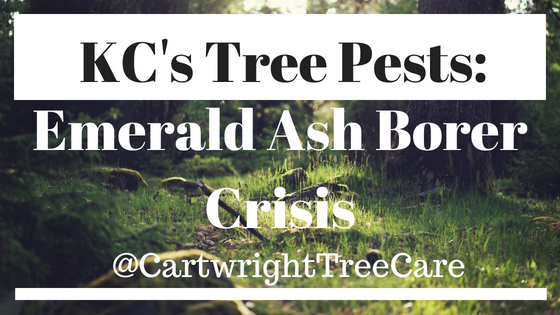
Kansas City's Pest Challenge | EAB Crisis
Kansas City has recently been facing a new epidemic. No, we're not talking about a new type of flu or virus. We’re talking pests here. In the past few years, the Emerald Ash Borer has become quite invasive and we are seeing more and more property owners being affected by these pests.
This crisis is causing damage to beautiful, established trees. Don’t fret though. We are going to tell you how to identify these critters and prevent damage to your trees and property.
The Emerald Ash Borer, when it comes down to it, is just a beetle. However, it has become an invasive species in North America, and both Kansas and Missouri have been affected by the Emerald Ash Borer or EAB.
The EAB is a metallic green beetle that is about a third of an inch long when it is full grown. This beetle can usually be seen chomping on the leaves of ash trees during the day as they love the sun. They are most commonly seen from May to July 1 as this is their peak season as adults emerge from inside the oaks and begin to mate.
The Emerald Ash Borer’s overall lifespan is not long. They only live for one to two months depending on their gender. Females live longer to lay eggs naturally. Since the Emerald Ash Borer loves to mate in the later afternoon and evening, they can often be seen around the base of trees in the early evening hours from June to July.
If you see a green metallic beetle around your Ash trees or near cracks in the trunk, seek out a certified arborist as soon as you can and have them inspect the affected tree. Emerald Ash Borers can take a while to completely damage a tree, so it is possible to catch and correct the issue.
Early signs of problems can be yellowing tree leaves and damage to the upper canopy or cracked upper limbs. At this point, a pest treatment could be done to help remedy the issue. If left to progress you may need to explore more drastic action such as tree removal.
So, if you are in the Kansas City metro area, keep your eye out. If you see signs of the Emerald Ash Borer on your property or lawn, give Cartwright Tree Care a call and have one of our professional arborists help to investigate the issue and provide a plan of action.
Sources:
- “Biology of Emerald Ash Borer - Invasive Species - Forest Disturbance Processes - Northern Research Station - USDA Forest Service.” Effects of Emerald Ash Borer on Forest Ecosystems - Emerald Ash Borer - Forest Disturbance Processes - Northern Research Station - USDA Forest Service, www.nrs.fs.fed.us/disturbance/invasive_species/eab/biology_ecology/planipennis/.

